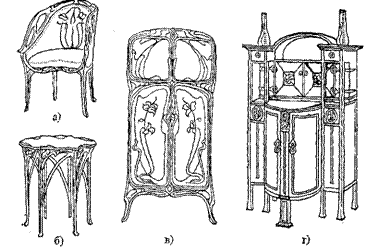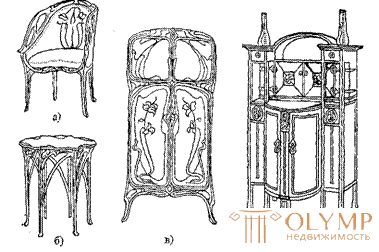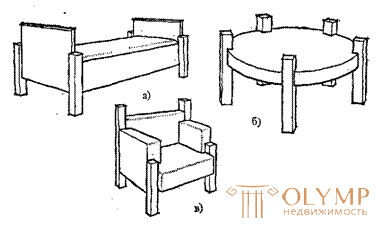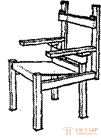
The rapid development of the industry, many artists and artists perceived as a direct threat to art. A protest against the manufacture of handicrafts of decorative and applied arts (furniture, dishes, ceramics, decorative fabrics) arose first in England. This protest was expressed primarily in the theoretical works of John Reskin (1814-1900) and the activities of William Morris (1834-1896), who tried to revive medieval craft and handicraft equipment. A peculiar propagandist of the ideas of V. Morris was his own house in Eton, designed by F. Webb.
In his practical work, Morris turned mainly to medieval art. The products of the workshops were distinguished by high formal merits in comparison with industrial products and successfully endured a comparison with antiques. However, Morrisov tapestries, carpets, bronze, binders, decorative fabrics, etc., were perceived as antiques, as “modern antiquities”.
Morris's motto is beauty and convenience. He first made his main principle the struggle for the quality of all those products that form the objective environment of the home. Morris found followers in other European countries
In the last decade of the XIX century. most European countries are developing a new style in bourgeois art - modern (French moderne - the newest, modern), which was designed to update all the artistic design of bourgeois life. Architects and artists were looking for new ways in art. They wanted to reveal the correspondence of new forms to modern materials: reinforced concrete, metal, glass, new technical requirements.
The dwelling architecture is being solved in a new way, which begins to be interpreted as a single interacting organism, which must satisfy not only the material, but also the spiritual needs of a person.
A new functional scheme of a residential house is being created. The principle of symmetry and enfilade of housing construction is rejected. The group of ceremonial rooms is separated, which includes the living room, dining room, and the owner's office. The dining room is already equipped not only with artistic, but also with special hygienic requirements. In its center there is a round or rectangular table, served with porcelain and silver, decorated with flowers in vases. Buffet (or sideboard) is used to show beautiful utensils and dishes. The office combines the functions of a workplace and a place for business meetings. From here restrained nature of its equipment and design, calm colors. All the rooms of this group are connected by a lobby equipped with a coat rack or a wardrobe for the top dress.
Another group of premises is family living rooms. The largest of them, designed for family holidays and family meals, is furnished with a large table, wardrobe or cupboard, chairs, sometimes a sofa. The furniture here is simpler and more practical.
The main motivation for all the innovations was the search for uniquely individual solutions both in the interior composition and in the forms of utensils, furniture and even ornament. Art nouveau has become characterized by picturesqueness, drawing, plasticity of forms, flowing “vegetable” lines that outline window bindings, portals, chairs, lamps, and wavyly repeat in the wallpaper pattern. The ornament masks the constructive solution of the architectural elements of the interior of the furniture.
Wavy outlines are given to the metal, and plaster, and wood, and concrete. The combination of different textures and materials - natural textures, painted wood surfaces, all kinds of inlays of glass and ceramics, lining of metal, polished or laminated - is subject to the chosen rhythm and artistic theme. All forms and tones are not organized on the principle of contrast, juxtaposition, but rather repetition, assimilation, unison.
The first country in which there was a new direction in the applied arts, was Belgium. The main role in the formation of the new movement belonged to the architect Henri Vam de Velde (1863-1957). The name Van de Velde is associated with the opening in Paris in 1895 of an art shop-salon “Ar Nouveau”, which gave the name to a whole period in European applied art. At the invitation of German artists and industrialists, Van de Velde moved to Berlin, where in 1898 a special society was established, which set itself the task of acquiring and executing his projects. In Germany, he published a number of articles and the book The Revival of Modern Applied Art, in which he summarized his principles.
In 1902, Van de Velde left Berlin and settled in Weimar, where on April 1, 1908 he opened the School of Applied Arts. One of the most important techniques transmitted by Van de Velde to his students was the use of ornamental flowing lines that decorated furniture, wallpaper, decorative items, etc.
In the furniture of modern style (Fig. 1), two opposite directions are distinguished: the first is purely decorative, using different flow lines; the other — constructive — straight lines and clear construction. The latter is especially characteristic of Germany and England.
In the furniture used expensive materials and a variety of ways and types of finishes: intarsia, painted accessories, mother of pearl, ivory, metal, etc.

Fig. 1. European modern furniture: a - a chair, b - a table with six legs, a - a small wardrobe, g - a multifunctional wardrobe
The crisis of the art industry of the period of modernity came pretty soon as a result of the revision of the aesthetic attitude to technology, to the car, to art forms. This change is most pronounced in relation to the domestic environment. The emergence of a new style was promoted by the industrialization of life itself: new household items (typewriter, gramophone, electrical appliances, vacuum cleaners, the latest telephone equipment, radio equipment, etc.) were incompatible with the old artistic and industrial aesthetics. At the beginning of the century, the starting principles of the new aesthetics of things were formulated. The new criterion, which began to measure the aesthetic value of things, has become expediency. Hence the revision of the role and place of things in everyday life.
The course on the expedient form, born by machine production, was meant to mean, first of all, the exposure of this form, its purification from decorative handicraft decoration. The simplest and most direct route of this technical form exposure is the rejection of the ornament. Therefore, anti-trend tendencies are the most characteristic formal sign of this stage in the development of the art industry.

Fig. 2. Bauhaus furniture (1919-1923): a - bed, b - stop, c - chair
In 1924, an exhibition was organized in Munich under the motto “Form without ornament”, where everything, from frying pans to curtains, was done in accordance with the principles of functionality and was designed for mass production. In the exhibited furniture samples, three main forms prevailed; a block is a volume inspired by a stone block that encloses the entire structure inside a flat case; a box consisting of lids, a frame and legs that formed a chest of drawers, a desk or sideboard, and a frame that revealed the design and is typical for use in tables and chairs. This new direction gets the name functionalism, the basis of which is the embodiment of the laws that are inherent in the forms produced by machine.
The focus of European functionalism was the Bauhaus, an architectural and art school founded in 1919 by the architect Walter Gropius in Germany.
The name “Bauhaus” (construction house) reveals the tasks of the school: the crafts here were subordinated to architecture. The general proportions and layout of buildings designed in Bauhaus were subject to technical requirements and were created taking into account social conditions and established customs.
Sharply starting from traditional styles, from the principles of decoration-vizma, the Bauhaus ideologues make their program installation the mass production of artistically decorated everyday things. For the whole course of functionalism, there is a desire to solve the whole domestic complex (dwellings, public building, street, quarter), carried out in unity, when all the constituent elements are subordinated to the main domestic function of the complex.
In the Bauhaus in 1919-1933. designed and manufactured furniture (Fig. 2), in which a constructive beginning prevailed. Things Marcel Breuer (Fig. 3) - one of the leaders of the Bauhaus - subject to artistic themes, close architectural structures.
Many prominent architects of the new time offered an original solution of chairs and armchairs. For example, the Dutch architect and designer Mart Stam created a series of wooden stools, chairs and armchairs of a centric design. Collected in a support beam hold the seat, back and armrests, which allows you to make the upper part of the rotating. The invention of the Strain marked the beginning of modern bar stools, work chairs and stools.
Functionalism was a progressive phenomenon in the furniture art of the XX century. and had a great influence on the formation of the modern style.
The development of Western European furniture in the first seventy years of the XX century. divided into three main stages. The first stage (1900-1914) is distinguished by the intensive development of artistic culture, the second (1919-1939) is associated with significant changes in artistic culture, the third period (1945-1970) is the time of the folding of modern forms, bold experiments related to the growth of technical capabilities, the time for searching .
Despite the general principles of design, a unified approach to the formation of modern furniture of each country has a peculiar character. So, the new style in Italy from the very beginning was distinguished by its luxury. This was not intended to create furniture designed for consumers in the middle strata of the population, as was the case in Germany, the USA and the Scandinavian countries.

Fig. 3. Marcel Breuer's chair
Sweden occupies a leading place among the Scandinavian countries in the field of applied and industrial art. At the beginning of the 20th century, the influence of folk national art was great in it, as exemplified by the Stockholm Town Hall, designed by Ragnar Estberg, and in which you can find samples of all kinds of national art crafts. The Swedish Pavilion at the 1925 International Exhibition (architect Karl Bergsten) is one of the examples of Swedish modernism. Then the influence of functionalism increases there, especially when creating cottages and apartment buildings. The Swedish Arts and Crafts Society and the Crafts Guild were founded in Sweden. These associations actively promoted modern style in the applied art, often staged exhibitions, were engaged in the manufacture of beautiful inexpensive and comfortable furniture. Back in 1919, a style of furniture that corresponded to national traditions took shape in Sweden.
Currently, Sweden is one of the leading manufacturers of high-quality furniture in Europe, the ancestor of shelving and sectional furniture. Established firms engaged in complex building equipment. In Sweden, there is a lot of literature on the theory of furniture design. Along with wood for the manufacture of furniture, especially public buildings, metal and plastics are widely used.
High culture distinguishes the production of furniture in Denmark. Denmark specializes in the manufacture of relatively labor-intensive products, the exquisite sculptural details of which (armrests, legs, accessories) are made of solid wood. Denmark produces household furniture designed for relatively large areas of the room.
Finnish furniture has long won recognition in the global market. Great influence on the development of Finnish furniture art had architects. Finnish artists are based on folk traditions. Composite and constructive solutions of furniture enable a person to feel at ease in the interior. Furniture is simple and soft forms. The ratio of colors, textures and textures of different materials are harmoniously aligned. The main material of the Finnish furniture industry is birch. When finishing wood prevail light colors.
Finnish architect Al-Avar Ato (1898-1976) was the first to use plywood as a carrier material (Fig. 4). Among nearly eight dozen
the models he created are best known for armchairs with armrests turning into poloski, a lounge chair with a seat and a back made of molded plywood, and round tables and chairs with curved wooden legs. Aalto furniture is manufactured by the world-famous Finnish company Artek.
Germany produces furniture for residential and public buildings. The shape of furniture products is close to the Scandinavian, but more geometric. For the decoration of furniture used traditional and modern materials and techniques. Developed public furniture. In particular, great attention is paid to the nomenclature, assortment, design, form and decoration of office furniture. In a large assortment of metal furniture is made for public buildings with working planes of wood.
For English furniture makers, it is characteristic to search for a combination of functional and artistic aspects of furniture products. Quite a few enterprises produce furniture in the style of the English Gothic of the 15th century, Dutch furniture of the 15th — 17th centuries, as well as in the style of Chippendale, Heplaywhite and Sheraton. In England, the production of open sets for dining rooms and bedrooms is practiced: the buyer can choose the composition of the set he needs from a large number of elements uniformly solved in form, decoration, color and texture.

Fig. 4. Stool designed by architect Aalto
Что бы оставить комментарий войдите
Комментарии (0)